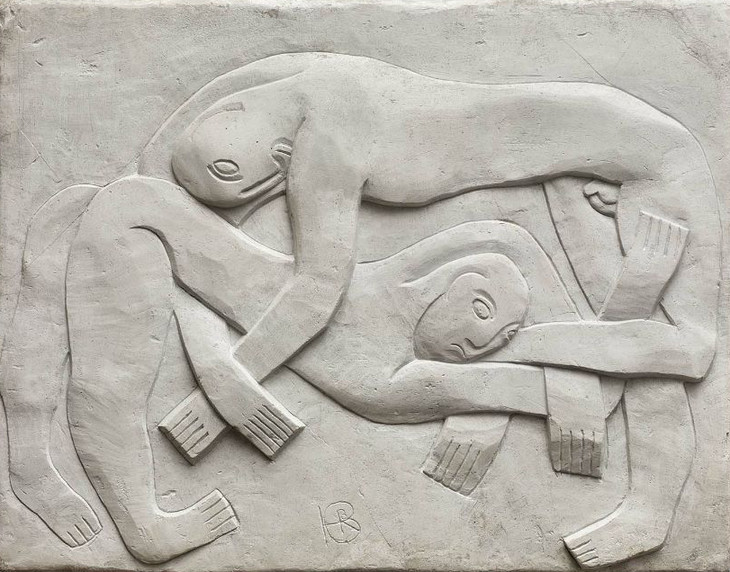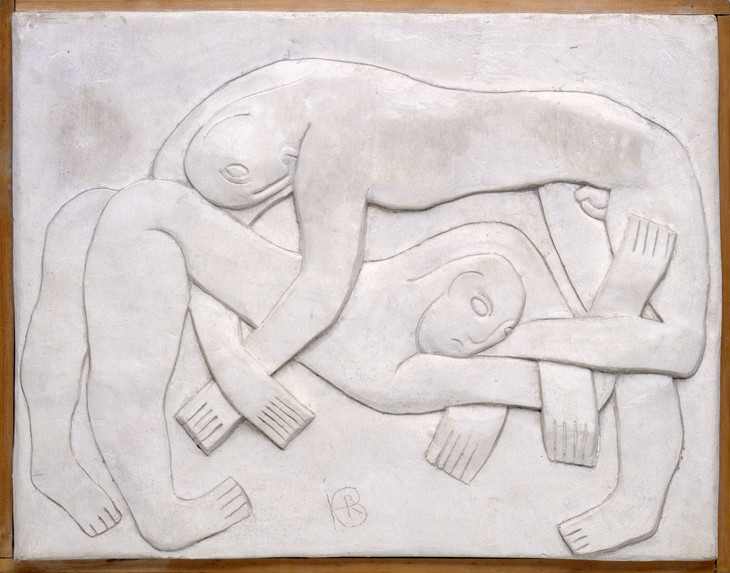Casting Wrestlers

Henri Gaudier-Brzeska
The Wrestlers 1914
Plaster
718 x 921 mm
Museum of Fine Arts, Boston
Fig.1
Henri Gaudier-Brzeska
The Wrestlers 1914
Plaster
718 x 921 mm
Museum of Fine Arts, Boston

Henri Gaudier-Brzeska
Wrestlers 1914, cast 1965
Plaster
711 x 927 x 76 mm
Tate T00837
Presented by Kettle's Yard Collection Cambridge 1966
Tate
Fig.2
Henri Gaudier-Brzeska
Wrestlers 1914, cast 1965
Plaster
711 x 927 x 76 mm
Tate T00837
Presented by Kettle's Yard Collection Cambridge 1966
Tate
The original Wrestlers relief (fig.1) was acquired by H.S. (Jim) Ede (1895–1990) in 1927 following protracted negotiations that saw him purchase the estate of Gaudier-Brzeska’s companion, Sophie Brzeska, for sixty pounds from the Treasury.1 On Gaudier-Brzeska’s death, all of his possessions and the contents of his studio had been inherited by Sophie, who died in 1925. After a search for next of kin had been exhausted, the Treasury sought to sell the collection but without success. The Tate Gallery agreed to take three sculptures and seventeen drawings on permanent loan. The Contemporary Art Society then took three sculptures and eighteen drawings (Jim Ede was also the secretary of the Society). The remainder – nineteen sculptures, thirteen oil or pastel paintings, 1,595 drawings, some sketchbooks and notebooks, some personal letters, as well as Sophie’s diaries and creative writings – were purchased by Ede via his friend Edward McKnight.2
The relief remained with Ede for the next forty years, and from 1956 was part of his collection of modern art that he kept in his newly renovated house at Kettle’s Yard in Cambridge. Aiming to disseminate Gaudier-Brzeska’s work and promote him as an important modern artist of the twentieth century, in Britain and internationally, Ede had casts made of many of the sculptor’s works. As with Wrestlers, Ede often commissioned numerous casts of a single sculpture. He justified his actions to Norman Reid, Director of the Tate Gallery from 1964–79, saying, ‘Personally I think Gaudier-Brzeska a special case for there is so little of his work for the world.’3
In June 1965 Ede commissioned John W. Mills, who was then teaching at St Alban’s School of Art, to make nine casts of Wrestlers (the British Board of Trade had ruled that casts of artworks were tax exempt if produced in an edition of nine or under). It is perhaps not surprising that Ede wanted several casts made if the art historian Francine A. Koslow is correct in claiming that he considered Wrestlers to be one of Gaudier-Brzeska’s most beautiful works.4 Ede sold the original to the Museum of Fine Arts in Boston in 1965. He knew that he was really selling the Museum of Fine Arts two works – the Wrestlers relief and the rare oil painting Whitechapel Jew on the back to which, Koslow reports, Ede drew attention in a letter to Hans Swarzenski, then curator of the Department of Decorative Arts and Sculpture in Boston.5 In addition to giving a cast of Wrestlers to the Tate Gallery (fig.2), Ede donated one to the Musée national d’art moderne in Paris, and kept two for Kettle’s Yard. Other casts went to private collectors. As art historian Evelyn Silber has noted, Jim Ede kept casual records about the casting process of the works in his collection, but nine or twelve casts was usually the maximum.6
The poet and friend of the artist, Ezra Pound, however, would certainly not have approved of the casting of Gaudier-Brzeska’s work, even if it did serve to disseminate his work among numerous important collections. As early as 1916 Pound was grumbling about the reproductions of the sculptor’s work stating that:
Photographs of sculpture are unsatisfactory but they are better than nothing. They are perhaps better than casts, especially in the case of a sculptor who held so much by his material, who never cut in one sort of stone a work more fitting another sort, and who cut direct, when he had marble or alabaster, or even the metal.7
Pound was adamant that Gaudier-Brzeska was a ‘direct carver’ and this, for Pound, meant carving in stone. When it came to his own portrait bust, Pound spent two month’s salary on a four foot block of stone, or, as he wrote to his mother, a ‘ton of Pentelicon for my head’.8 Pound considered plaster a ‘detestable medium’, despite Gaudier-Brzeska’s frequent use of it.9 In her work on avant-garde aesthetics in early twentieth-century London, art historian Lisa Tickner has observed that carving was thought of as ‘virile’.10 Both Pound and Gaudier-Brzeska, via the language and practice of direct carving, advanced a masculine, muscular version of modernism in the period shortly before the First World War but Wrestlers occupies a complex position within these discussions. It was, on the one hand, a depiction of a suitably ‘tough’ subject – two men wrestling – yet the touch of their bodies is intimate, rather than aggressive. And it was carved directly but in that ‘detestable’ and soft (even when hard) medium, plaster.
Although Pound may have scorned casts of Gaudier-Brzeska’s sculptures, Silber notes pragmatically that doubts about ‘the desirability of all these casts, especially those taken from carved works and from plasters of which earlier bronzes already existed’, must be balanced against the fact that they ‘played an extremely important part in fostering Gaudier-Brzeska’s reputation’.11 Also, the revenue generated by the sale of casts ensured the survival of ‘the unique ambience’ of Ede’s home, Kettle’s Yard, which he presented to the University of Cambridge in 1966, and allowed him to present numerous other sculptures and drawing to art galleries and museums.12 It is also worth remembering that sculptural reproductions have played an important role in the history of the world’s art for millennia (consider the number and importance of Roman copies of Greek sculptures). However, the issue of posthumous casting seems to have become increasingly controversial in the twentieth century.13 It is of course impossible to know what Gaudier-Brzeska would have thought about the posthumous casts made of his work, although for a sculptor who went to so many efforts to construct an artistic identity as a ‘direct’ carver, it is not difficult to guess. Gaudier-Brzeska was nonetheless in good company in having his work cast after his death: Constantin Brancusi, Raymond Duchamp-Villon, Umberto Boccioni and Julio Gonzàlez, all had sculptures posthumously cast, some more controversially than others.14
The original plaster and herculite (a strong and very white type of plaster composed of a gypsum mineral) casts are fragile. In a letter to Jim Ede, now in the Tate Archive, Mary Chamot, an assistant keeper at Tate, wrote to him saying that the gallery was nervous about putting plaster works on public display due to their vulnerability.15 Ede replied to her agreeing that plasters were problematic but emphasised the importance of the works (including his cast) as originals, saying that ‘on account of their being original carving[s] in plaster’, they were ‘from a point of view of chisel and finger marks, most valuable’.16
Notes
A detailed account of the estate and its acquisition can be found in Roger Cole, Gaudier-Brzeska: Artist and Myth, Bristol 1995, pp.187 ff. Sebastiano Barassi and Jon Wood have also provided new insights on this purchase in their co-written essay ‘”Something about an Artist, and Poverty and Love and London”: The Story of the Savage Messiah’, in H.S. Ede, Savage Messiah: A Biography of the Sculptor Henri Gaudier-Brzeska, Cambridge and Leeds 2011, pp.241–55. They comment that, although this was a modest sum for all that Ede was acquiring, it was nevertheless ‘a substantial portion of his annual income of around £260’. See, in particular, p.243 note 3.
Francine A. Koslow, ‘The Evolution of Henri Gaudier-Brzeska’s “Wrestlers” Relief’, Museum Bulletin of the Museum of Fine Arts Boston, vol.78, 1980, p.40.
Ezra Pound, letter to his mother, Isabel Pound, undated [1914], The Yale Collection of American Literature, Beinecke Rare Book and Manuscript Collection of American Literature, Yale University, New Haven, cited in Lisa Tickner, ‘Now and Then: The Hieratic Head of Ezra Pound’, Oxford Art Journal, vol.16, no.2, 1993, p.56.
How to cite
Sarah Victoria Turner, ‘Casting Wrestlers’, July 2013, in Sarah Turner (ed.), In Focus: 'Wrestlers' 1914, cast 1965, by Henri Gaudier-Brzeska, Tate Research Publication, July 2013, https://www
